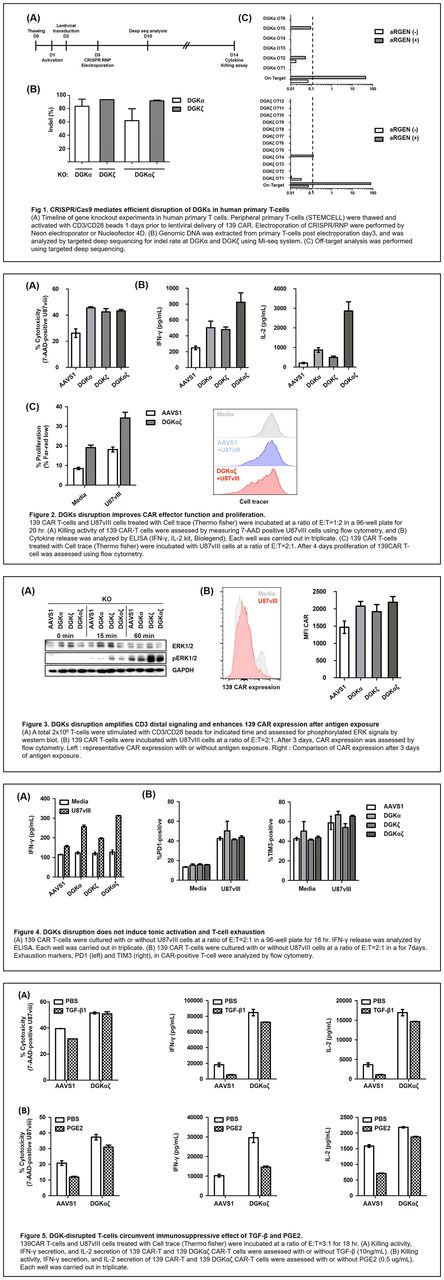Abstract
Introduction
Tumors can evade immune surveillance by deactivating T cells via various immunosuppressive ligands and soluble factors. The inhibitory signals from tumors turn on or off specific signaling pathways of T cells, making T-cell therapy inefficient. Many efforts for efficient adoptive T-cell therapy have focused on blocking or inhibiting CD28/B7 pathway, signal2, by targeting PD1 or CTLA4, but robust therapeutic outcomes have remained challenging. Diacylglycerol (DAG) is an essential signal transduction molecule cascading CD3 signal, signal1, and DGK is an enzyme that phosphorylates DAG to phosphatidic acid (PA). In many tumors, DGK was found to be highly expressed in tumor infiltrating lymphocytes (TILs) and inhibition of DGK recover the dysfunction of TILs. In this study, we sought to invigorate the T-cell function by deleting Diacylglycerol kinase (DGKs) using CRISPR/Cas9. We found that ablation of DGKs potentiates anti-tumor function and proliferation of CAR-T cell, by strengthening the CD3 distal signals. Also, DGKαζ (two isoforms) knockout (KO) CAR-T showed no significant elevation of exhaustion markers, and was less responsive to immunosuppressive soluble factors, such as TGF-beta and prostaglandin E2. Collectively, these findings highlight the utility of DGK KO by CRISPR/Cas9 to reinforce the effector function of T-cell. The observed biological effects of DGK KO may also yield new strategies for improving the efficacy of T-cell therapy in combination with signal 2 checkpoint inhibitors in clinical applications.
Methods
Human pan-T cells were purchased from STEMCELL TECHNOLOGIES. X-VIVO15 media was supplemented with hIL-2 (50 U/mL) and hIL-7 (5 ng/mL) for culture, and activation was performed by using anti-CD3/28 Dynabeads (ThermoFisher SCIENTIFIC) at bead-to-cell ratio of 3:1. After 24 hours of activation, T-cells were mixed with 139-CAR lentivirus plates coated with Retronectin for 48 hours. 40 μg of recombinant S. pyogenes Cas9 (Toolgen) and 10 μg of chemically synthesized tracr/crRNA (Integrated DNA Technologies) were electroporated using 4D-Nucleofecter (Lonza).
For in vitro assays, U87vIII, pre-stained with Cell Trace (ThermoFisher Scientific), was co-cultured with 139 CAR-T at indicated ratio, supplemented with or without TGF-β1 at 10 ng/mL and PGE2 at 0.5 ug/mL. Following co-incubation, cells were stained with 7-aminoactinomycin for cytotoxicity assays. Sample were acquired on Attune NxT Acoustic Focusing Cytometer, and analyzed with FlowJo. Cytotoxicity was calculated as [(%lysis sample-% lysis minimum)/(%lysis max [100%]-%lysis minimum]×100%. The supernatant of co-culture was analyzed to measure IL-2 and IFN-γ using ELISA Kit(Biolegend). For proliferation assays, distribution of CellTrace in 139 CAR-T cells was assessed using flow cytometry.
Results
In following experimental scheme (Fig 1A), delivery of single Cas9/gRNA Ribonucleoprotein (RNP) complex targeting DGKα or DGKζ resulted in 75.9% and 93.5% of Indel, respectively in 139 CAR-T (Fig 1B). To generate DGKα and DGKζ double-negative 139 CAR-T cells, two gRNAs targeting DGKα and DGKζ were electroporated, which resulted in 49.2% and 92.4% indel, respectively (Fig 1B). No significant off-targets were detected by targeted deep-sequencing (Fig 1C). DGKα, DGKζ, and DGKαζ KO 139 CAR-T showed dramatic increase in cytotoxicity, multiple cytokine production, and proliferation capacity compared to wild-type 139 CAR-T (Fig 2A, B, C). Interestingly, DGKαζ KO 139 CAR-T showed further increase in cytokine release compared to DGKα or DGKζ single KO one, implying a synergistic effect of DGKα and DGKζ. The increase in effector function of DGK KO 139 CAR-T attributed to amplified CD3-distal signal, ERK1/2, and higher CAR expression after antigen exposure (Fig 3A, B). Despite of the strong activation signals in DGKs KO 139 CAR-T, no significant tonic activation was observed as indicated by basal IFN-γ secretion level (Fig 4A). Also, in comparison with 139 CAR-T, PD1 and TIM3 expression were not elevated in DGKs KO 139 CAR-T, suggesting that DGKs KO does not facilitate T-cell exhaustion after long term antigen exposure (Fig 4B). In contrast that anti-tumor effect of 139 CAR-T was markedly impaired with treatment of signal1 immunosuppressive inhibitors such as TGF-β1 and PGE2, DGKαζ KO 139 CAR-T maintained its cytotoxicity and cytokine release in the presence of the inhibitory soluble factors. (Fig 5 A, B)
No relevant conflicts of interest to declare.
Author notes
Asterisk with author names denotes non-ASH members.


This feature is available to Subscribers Only
Sign In or Create an Account Close Modal